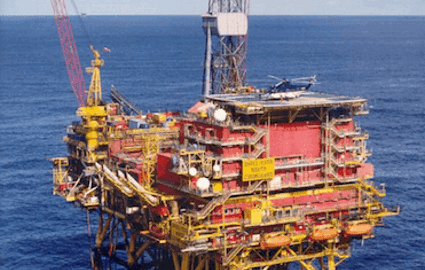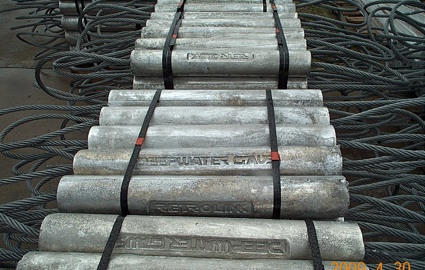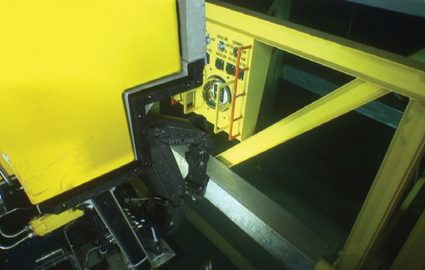TECHNICAL ARTICLE
Continued operation of large offshore platforms requires innovative new CP systems to be retrofitted
by Alex Delwiche and Jim Britton
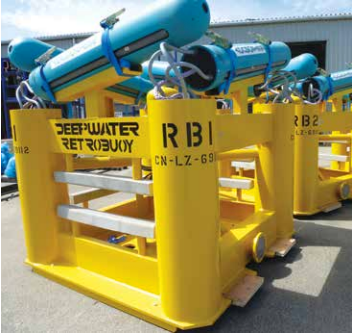
Figure 1 - 950 Ampere ICCP Anode Sled
Many large structures, and other offshore producing areas in the North Sea, are needing to stay operational beyond their original design life. The reasons for this are typically driven by improved geological survey and recovery technologies, that keep the reservoirs viable, and the advances in subsea production systems which, through subsea tiebacks, keep the oil and gas flowing.
This article discusses the difficulties in undertaking cathodic protection upgrades to offshore oil and gas structures, and discusses examples of where the authors’ company have undertaken upgrades or retrofits to a number of structures in UK waters.
Most of these structures were commonly equipped with sacrificial anodes in the fabrication yard, a relatively straightforward process, as the anodes were usually attached when the jacket framing was at ground level before being “rolled up into the vertical” position. In the seventies, some operators promoted the use of coatings on these facilities to reduce the number of anodes required, especially where zinc anodes were favoured over AL-Zn-In or Al-Zn-Hg. Other operators reviewed the CAPEX financial figures and opted to just increase the number of anodes, which was normally the most cost effective option. This resulted in the case of a large bare steel structure with the attachment of around 2476 anodes, with a combined weight of 666,000 kg (1). Many of these structures were designed to provide around a 20 to 25 year life.
When designing large sacrificial anode systems, two things are very important. The first being to provide sufficient anodes to deliver the required current density (mA/m2) to the submerged structure, to ensure that optimum levels of cathodic protection are established, and that it is evenly distributed to all areas of the submerged structure. This current density is normally referred to the initial, or polarization current density, and following the present design codes, is recommended to be 150 to 180 mA/m2 in the Southern and Northern North Sea areas respectively (2). The second important item is to ensure that there is sufficient mass of sacrificial material to provide the required current for the design life, given that aluminium anodes typically waste at a rate of 3.5 Kg/Amp/ Year. However, to calculate the mass of anodes required, the current density can be reduced to a lower level of 90 mA/m2 which is the number quoted in the design standards as the mean or maintenance current density. The large difference between these numbers is significant when considering the question of continued extended operation.
If a cathodic protection system that has established protective deposits on the steel surfaces, and is still able to “maintain” these deposits, at about half of the theoretical design current requirement, then it is strategically advantageous to extend the system life while it is operating at this maintenance level, rather than going back to the initial, or polarization level again. It is for this reason that a pro-active intervention is recommended, whereby cost savings can be significant.
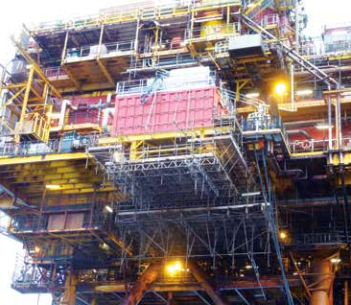
Figure 2 - Containerised unit on the platform
A recent example is the retrofit to an aging Northern North Sea structure, to allow continued operation. This structure was originally installed in 1979 and was fitted with the 2476 sacrificial anodes mentioned earlier. In 2010 there was evidence that the protection levels were below the required criteria. Studies concluded the current required to extend the life was 7500 Amperes. This high current requirement presented a challenge, and was actually a compromise number. Had the new build design standards been followed, the number would have been considerably higher.
Following, a review of the options available, either sacrificial or impressed, it was quickly concluded that a sacrificial system, as a like for like replacement of anode mass, either directly on the structure or located on the seabed, was not a financial option, and was not achievable due to lack of seabed space. Further reviews concluded the most viable option was for a remote ICCP anode sled, however with the amount of predicted current, the required number of standard “off the shelf” systems also was cause for concern. A 450 amp ICCP system was readily available following development over 20 years by our company, however the number of systems needed to meet the current requirement was unworkable, due to available sites on the sea bottom, the number of cables required, and topside space constraints for location of power units. The solution was to re-engineer the standard system to double its current capacity to 950 Amps, thus halving the number of units. This also required the re-design of the cables and the power units (figure 1).
Due to lack of space on the platform, a deck extension was added to accommodate a customised container which contained the 8 x 950 A transformer rectifier units (figure 2).
The replacement system was deployed in 2016, and was commissioned that same year. The structure is now fully protected with the system operating well within its capacity. Figure 3 shows a typical depleted anode with the CP level at (-) 0.675 V vs Ag/AgCl, well below the required level prior to the retrofit.
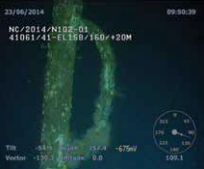
Figure 3 - Example of depleted anode at EL158
On another group of structures, installed in 1974, the original approach was to coat the structures in addition to cathodic protection. Part of the reasoning for this approach could well have been that the zinc anodes chosen, with a reduced current capacity when compared to aluminium anodes (780 Ah/kg to 2500 Ah/kg respectively), the number and weight of which required for a bare steel structure would have presented problems. The designer (3) concerned confirmed that the coated and zinc anode option was slightly more cost effective than without coating and the owner/ operator preferred zinc to aluminium anodes, as they had bad experiences with aluminium at that time. Each structure was fitted with 800 zinc anodes each weighing 360 kg, totalling 288,000 kg. It should be noted that these structures are approximately half the size of the one described above (when considering the wetted surface area).
Obviously there are many differences between the two types of structures which have a knock on effect on any life extension programme. This field was sold in 2003 to another operator, who evaluated the situation and concluded that life extension beyond the original design life of the assets was necessary, due to presence of new reserves. When this situation was realised an extensive programme of upgrades was implemented, including that of the CP system, which predictions, including CP modelling, had determined would not last beyond 2012., whereas the extended design life desired as of 2008 was 15 years.
The strategy programme for the two operators was different - one had a failing CP system when the structure was purchased and had to commission a retrofitted CP system, the other operator had a CP system that was performing well because of the coating, but opted for a proactive approach when it was clear that the system would not last through the required life extension.
Two x 500 Amp systems were therefore fitted to each of these structures (3 x 500A on one platform). This was a redundant measure since the actual current required was calculated at about half this amount. The systems are currently operating at around 20% of their design capacity. The design was cross checked by various methods including anode depletion and computer modelling. It is worth noting that the cost of doubling the current capacity represented only a 10% increase in total project cost.
As can be seen, the difference in retrofitted current requirement between the two scenarios is significant, which reflects the number and complexity of the equipment necessary to fulfil the current upgrade requirements.
Both the above projects were in the Northern North Sea in relatively deep water (more than 100 m depth). A recent project that has just been executed was in the Southern North Sea. The requirement again was for a life extension of a well-known and strategic gas field (Figure 4).

Figure 4 - Part of the Southern North Sea Complex
To complicate the upgrade requirements, the life extension was for a series of bridge-linked jackets. Most were installed with a galvanic anode system, but one jacket had been built with a close mounted ICCP system that had unfortunately failed very early on. The latter gave little confidence to the owner/ operator about ICCP systems generally offshore, although the technology at the time, albeit ground breaking, was not engineered adequately to survive the harsh North Sea environment. Having continually upgrading the cathodic protection systems at great cost each time with jacket mounted anodes, as a strategic gas field with significant long term gas reserves, the owner/ operator took a step back, reflected on the overall long term cost and took the plunge, and went forward with a remote anode retrofit system.
The southern North Sea environment is totally different to the relatively calm depths of the Northern North Sea. Albeit the current requirement for maintenance was not anywhere near as high as for the larger structures, but being a complex with multiple undocumented anode replacements, the actual current required was difficult to determine. The owner/operator was advised by a series of specialist consultants that the existing and retrofitted anodes would not last for the extended life of the gas field, and some areas of the complex were already seeing signs low protection levels.
Studies were undertaken by our company and third parties, that confirmed a remote anode ICCP system would be the most effective system in terms of overall installed cost, and a 30% redundancy was included which resulted in three 500 A systems being recommended.
However, due to the fast flowing, shallow conditions, the subsea equipment had to be modified to withstand the high bottom currents and the scour tendencies in the area.
The redesign resulted in an increased gravity base mass, extra tether arrangements fitted to the buoyant anode modules, and supplementary cable protection using flexible concrete mattresses ( Figure 5 and Figure 6). The flexible mattress system allowed for the stability design to be optimised, reducing the handling cost of a traditional steel formed concrete mattress, and flexibility of where the mattress could be assembled and cast locally to the job site. The subsea ICCP system took only three days to install, with each concrete mattress being laid every 20 minutes, thanks to the planning and dedication of the owner/operator and subsea installer. As can be seen in Figure 7 the deck layout required intricate planning.
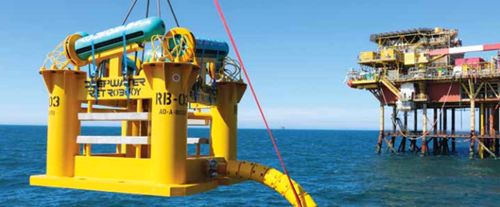
Figure 5 - Heavyweight and additional tether arrangement ICCP anode sled
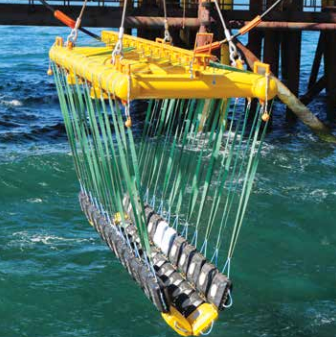
Figure 6 - Example of a flexible concrete mattress system being laid
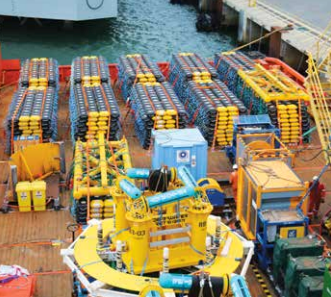
Figure 7 - Equipment laid out on the vessel
Conclusions
Cathodic protection life extensions, are by definition, customised on a project by project basis. It pays the owner to complete a front end engineering exercise to determine the optimum solution. It also pays to include healthy levels of redundancy in the designs, based on the small incremental cost of this provision. The original corrosion protection designs by various owner/operators have proved that coating the structures has been an excellent system, as a means of controlling the need for additional cathodic protection requirements, where longevity is required. The three examples provided have shown that remotely installed impressed current CP systems offer a cost effective and reliable solution to extend the life of large offshore structures.
References
(1) Design and Operational Guidance on Cathodic Protection of Offshore Structures, subsea installations and pipelines (The Marine Technology Directorate Ltd) 1990. MTD Ltd Publication 90/102
(2) BS EN 12495: 2000 Cathodic Protection for Fixed Steel Offshore Structures
(3) Thanks to Michael Pursell, retired Corrosion Engineer, for contributing to this article


